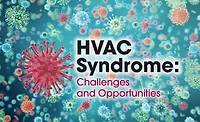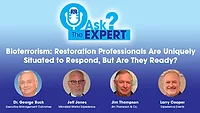Bioterrorism Cleanup
Bioterrorism is defined as, “The unlawful use, or threatened use, of microorganisms or toxins derived from living organisms to produce death or disease in humans, animals or plants. The act is intended to create fear and/or intimidate governments or societies in the pursuit of political, religious, or ideological goals.”

Bioterrorism is defined as, “The unlawful use, or threatened use, of microorganisms or toxins derived from living organisms to produce death or disease in humans, animals or plants. The act is intended to create fear and/or intimidate governments or societies in the pursuit of political, religious, or ideological goals.”
The Centers for Disease Control recognizes these diseases and agents, among others, as bioterrorism threats: anthrax; botulism; plaugue; ricin; smallpox; sarin and tularemia. They fall into different categories. Smallpox is viral, while plague is a bacterial disease. Sarin is a manufactured chemical.
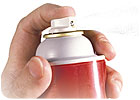 The CDC categorizes bioterrorism agents into three levels, A through C. Category A agents are high priority and include organisms that pose a risk to national security. Category B agents are those that are moderately easy to disseminate and result in moderate morbidity rates and low mortality rates. Category C agents are emerging infectious diseases such as Nipah virus and Hantavirus. Category C also includes emerging pathogens that could be engineered for mass dissemination.
The CDC categorizes bioterrorism agents into three levels, A through C. Category A agents are high priority and include organisms that pose a risk to national security. Category B agents are those that are moderately easy to disseminate and result in moderate morbidity rates and low mortality rates. Category C agents are emerging infectious diseases such as Nipah virus and Hantavirus. Category C also includes emerging pathogens that could be engineered for mass dissemination.
There are hundreds of possible bioterrorism agents. The ones most likely to be encountered have distinct characteristics such as availability, ease of production, lethality, stability and infectivity. Terrorists are looking for the largest amount of damage in relation to the risk factor of a successful attack. At least 17 nations are currently known to have offensive biological weapons programs.
Every agent poses a different threat to those who come in contact with them. Generally speaking, the biggest threat is through inhalation. Dermal contact is a smaller problem. Symptoms from exposure do not usually manifest themselves right away, and this leads people toward being less than cautious.
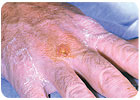
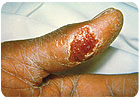 Acidic compositions are usually more effective than alkaline ones due to stability, speed of efficacy and the broad spectrum of biocidal activity. They are more effective and will not be rejected from the surface of negatively charged micro-organisms e.g. gram positive bacteria. Acidic compositions enhance virucidal activity by rapidly inactivating the pathogen. Understanding their particular limitations is critical.
Acidic compositions are usually more effective than alkaline ones due to stability, speed of efficacy and the broad spectrum of biocidal activity. They are more effective and will not be rejected from the surface of negatively charged micro-organisms e.g. gram positive bacteria. Acidic compositions enhance virucidal activity by rapidly inactivating the pathogen. Understanding their particular limitations is critical.
Peroxygens offer a somewhat better option. Decontamination operations based on peroxygen chemistry satisfy multiple key criteria. They have excellent environmental profiles and, unlike hypochlorite-based systems, can be co-formulated with other co-actives depending on product format. It is possible to formulate peroxygen-based powders with broad-spectrum activity (e.g. Virkon) that generate acidic solutions and have an end product effective in the presence of soil, in hard water, at low temperatures and across the pH spectrum.
Bleach is a well-known but historically misused biocide. In theory it should be effective, but in reality the solutions have a number of significant drawbacks that bring into doubt its effectiveness as a decontaminant. Solutions are rapidly inactivated by organic matter. In-use solutions are typically unstable and decompose rapidly. There is variable shelf life dependant upon manufacturer. Bleach solutions adversely affect metal surfaces and other materials such as rubber, plastics and soft surfaces. There are safety, health and environmental risks. Bleach cannot be mixed with cationic surfactants.
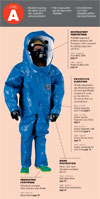
In a chemical spill situation, PPE must have the following minimum features:
A bioterrorism hazard site needs to be approached with an even higher concern. In that kind of situation your PPE should have these extended features:
Some key points to remember, and this applies to even the most mildly contaminated sites:
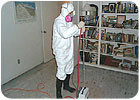
We live in an increasingly hostile world. That is a reality. Be vigilant. Be aware, but let reality work for you too. Knowledge is power so enlighten yourself if not just to expand your base of operations but also prepare for any eventuality. If you liked this feature circle 140 on page 51.

Bioterrorism is defined as, “The unlawful use, or threatened use, of microorganisms or toxins derived from living organisms to produce death or disease in humans, animals or plants. The act is intended to create fear and/or intimidate governments or societies in the pursuit of political, religious, or ideological goals.”
The Centers for Disease Control recognizes these diseases and agents, among others, as bioterrorism threats: anthrax; botulism; plaugue; ricin; smallpox; sarin and tularemia. They fall into different categories. Smallpox is viral, while plague is a bacterial disease. Sarin is a manufactured chemical.

There are hundreds of possible bioterrorism agents. The ones most likely to be encountered have distinct characteristics such as availability, ease of production, lethality, stability and infectivity. Terrorists are looking for the largest amount of damage in relation to the risk factor of a successful attack. At least 17 nations are currently known to have offensive biological weapons programs.
Every agent poses a different threat to those who come in contact with them. Generally speaking, the biggest threat is through inhalation. Dermal contact is a smaller problem. Symptoms from exposure do not usually manifest themselves right away, and this leads people toward being less than cautious.

Methods and Materials for Cleanup
By definition, a disinfectant can be heat, radiation or chemical in nature, as long as it has the desired result. The ultimate goal of a disinfectant is to destroy, neutralize or inhibit future growth of disease carrying microorganisms. In simple terms we could say its purpose is to “free from infection.” A proper disinfectant is dependant upon the nature and extent of the calamity. In each scenario certain properties must be in evidence.- It must be safe to use, fast acting and safe to dispose of once used.
- It should have wide application properties such as the ability to be fogged, sprayed or other means of application to reach maximum result in the shortest time possible.
- It should be easy to stock and transport to the contaminated site.
- Its efficacy should not be adversely affected by operating temperatures but rather be effective under all climatic conditions.
- It should be able to produce some residual cleaning effect as well as decontamination as this will speed up remediation.
- It should not need complex mixing or diluting to prevent application error.

Peroxygens offer a somewhat better option. Decontamination operations based on peroxygen chemistry satisfy multiple key criteria. They have excellent environmental profiles and, unlike hypochlorite-based systems, can be co-formulated with other co-actives depending on product format. It is possible to formulate peroxygen-based powders with broad-spectrum activity (e.g. Virkon) that generate acidic solutions and have an end product effective in the presence of soil, in hard water, at low temperatures and across the pH spectrum.
Bleach is a well-known but historically misused biocide. In theory it should be effective, but in reality the solutions have a number of significant drawbacks that bring into doubt its effectiveness as a decontaminant. Solutions are rapidly inactivated by organic matter. In-use solutions are typically unstable and decompose rapidly. There is variable shelf life dependant upon manufacturer. Bleach solutions adversely affect metal surfaces and other materials such as rubber, plastics and soft surfaces. There are safety, health and environmental risks. Bleach cannot be mixed with cationic surfactants.

Personal Protection Equipment
Defining the nature and extent of the situation will dictate the type and level of PPE required for cleanup. During the investigative stages it is imperative to hope for the best but plan for the worst when gearing up to enter a contaminated site. Except in a clearly defined case, such as a known chemical spill of an identified chemical, your level of personal protection equipment must be at the highest. Additional specialty items should include portable decontamination enclosures, proper disposal containers, specialized meters and detection equipment, and specially trained responders.In a chemical spill situation, PPE must have the following minimum features:
- Gas-tight zippers.
- Be designed for SCBA gear.
- Double-taped seams.
- Dual-glove system for dermal protection.
- Specially sealed face shield.
A bioterrorism hazard site needs to be approached with an even higher concern. In that kind of situation your PPE should have these extended features:
- Gas-tight and positive pressurization
- Be designed for SCBA gear
- Special resistant sewn seams
- Teflon overlay with chemical flash resistance
- Kevlar outer gloves
Some key points to remember, and this applies to even the most mildly contaminated sites:
- Choose the appropriate PPE for the job.
- Don all PPE before entering the contaminated area.
- Do not touch your face or adjust your respirator with contaminated gloves.
- Be careful that you do not allow your contaminated PPE to further spread the contamination by touch.
- Dispose of or decontaminate your PPE properly.
- Ensure that hand hygiene facilities are available outside the containment area.

Is Bioterrorism Cleanup in Your Future?
Only after considerable thought and consultation with other professionals should you make that decision. Most remediation contractors have the basic skill sets necessary to successfully enter this advanced field. Should you decide to expand your client offerings, a little research will go a long way. The CDC, EPA, OSHA and other organizations have volumes of free material available. Obtain it. Read it carefully. Discuss it with your staff and workers to get their input. Look at your current business model and where you want to be five or 10 years from now.We live in an increasingly hostile world. That is a reality. Be vigilant. Be aware, but let reality work for you too. Knowledge is power so enlighten yourself if not just to expand your base of operations but also prepare for any eventuality. If you liked this feature circle 140 on page 51.
Looking for a reprint of this article?
From high-res PDFs to custom plaques, order your copy today!



